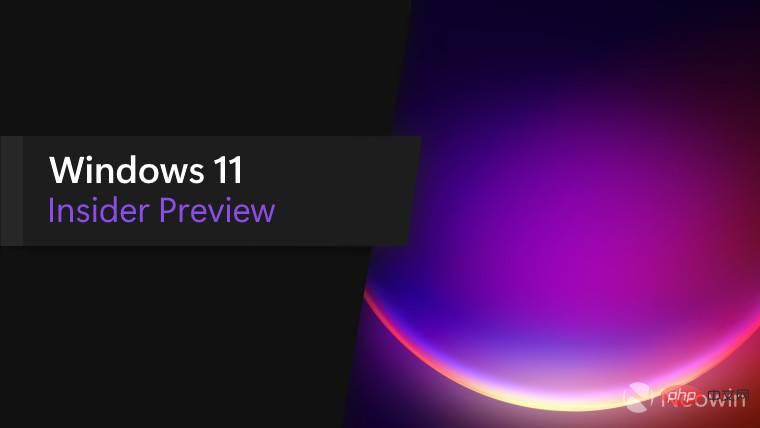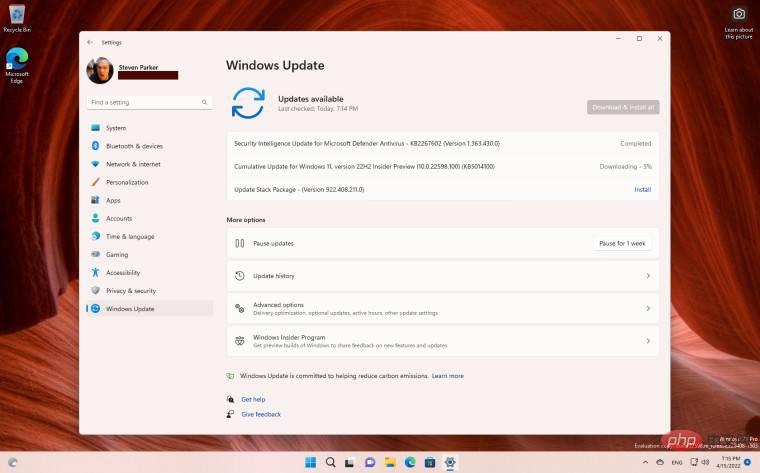 Common Problem
Common Problem
 Windows 11 servicing build 22598.100 (KB5014100) released to Dev and Beta Insiders
Windows 11 servicing build 22598.100 (KB5014100) released to Dev and Beta Insiders
Windows 11 servicing build 22598.100 (KB5014100) released to Dev and Beta Insiders

Microsoft today released a servicing update to Dev and Beta channel insiders containing new Windows 11 build 22598.100 (KB5014100). The new version does not bring anything new as it is a cumulative update and the company is testing its service pipeline as it is generally known. Microsoft releases service updates frequently now, as Dev Channel releases are filled with new and upcoming features.
The full announcement says:
We are starting to roll out cumulative update build 22598.100 (KB5014100). This update does not contain anything new and is intended to test the service pipeline we have built in the development and test channels.
As a result, all bug fixes and improvements announced in the earlier release, version 22598, have been brought to the development channel and test channel. This release comes with a ton of new features as we are now entering the next phase of Windows 11 in preparation for version 22H2.

Interestingly, while no new changes were made in this build, serving such test builds has been known to break some functionality. For example, Windows 10 Build 21292.1010 caused issues with x64 emulation on ARM PCs.
The above is the detailed content of Windows 11 servicing build 22598.100 (KB5014100) released to Dev and Beta Insiders. For more information, please follow other related articles on the PHP Chinese website!

Hot AI Tools

Undresser.AI Undress
AI-powered app for creating realistic nude photos

AI Clothes Remover
Online AI tool for removing clothes from photos.

Undress AI Tool
Undress images for free

Clothoff.io
AI clothes remover

AI Hentai Generator
Generate AI Hentai for free.

Hot Article

Hot Tools

Notepad++7.3.1
Easy-to-use and free code editor

SublimeText3 Chinese version
Chinese version, very easy to use

Zend Studio 13.0.1
Powerful PHP integrated development environment

Dreamweaver CS6
Visual web development tools

SublimeText3 Mac version
God-level code editing software (SublimeText3)

Hot Topics
 Solution to win10 snmp installation failure error code 0x8024402C
Feb 13, 2024 am 08:30 AM
Solution to win10 snmp installation failure error code 0x8024402C
Feb 13, 2024 am 08:30 AM
The snmp protocol is a simple network management protocol. This protocol can support the network management system and is used to monitor whether the devices connected to the network have any situation that causes management concern. However, many users have recently reported that the win10 installation of snmp failed with the error code 0x8024402C. what to do? Users can start Powershell as an administrator to set up. Let this site carefully introduce to users the solution to the error code 0x8024402C when installing snmp in win10. Solution to win10 snmp installation failure error code 0x8024402C 1. Start Powershell as administrator 1. The first step is to run the win10 system
 Detailed tutorial on installing Carla on Ubuntu 20.04 system.
Feb 19, 2024 pm 08:20 PM
Detailed tutorial on installing Carla on Ubuntu 20.04 system.
Feb 19, 2024 pm 08:20 PM
Carla is an open source autonomous driving simulation platform designed for developing and testing autonomous driving algorithms. The following is a detailed tutorial for installing Carla on Ubuntu20.04 system: Install dependencies: Open a terminal window and run the following command to install Carla’s dependencies: sudoaptupdatesudoaptinstall-ybuild-essentialclang-10llvm-10python3-pippython3-devlibpng-devlibjpeg-devlibtiff5-devlibopenexr -devlibhdf5-devlibsquish-de
 Switching from the Win11 Dev Channel to Win11 Beta is available for a limited time – here's how
May 10, 2023 pm 06:52 PM
Switching from the Win11 Dev Channel to Win11 Beta is available for a limited time – here's how
May 10, 2023 pm 06:52 PM
With the rollout of Windows 11 build 22581 to the Dev and Beta channels yesterday, this action indicates that the Dev channel will soon be moved to the CU (Copper) development branch, believed to be SunValley 3 or the third version of Windows 11 scheduled to be released sometime in 2023. The Beta channel will now use builds from the NI (Nickel) development branch, which is planned for the SunValley 2 development release later this year, or 22H2. So while they are currently the same version, if you want a more stable build you may want to consider moving to the Beta channel or even a Release Preview
 Ubuntu compilation and installation pcl tutorial.
Mar 16, 2024 am 11:52 AM
Ubuntu compilation and installation pcl tutorial.
Mar 16, 2024 am 11:52 AM
Compiling and installing PCL (PointCloudLibrary) is a way to install on Ubuntu with custom options. Here is a basic tutorial: Install dependencies: Before you start compiling PCL, you need to install some necessary dependencies. Open a terminal and run the following command: sudoapt-getupdatesudoapt-getinstallgitbuild-essentiallinux-libc-devcmakecmake-guilibusb-1.0-0-devlibusb-devlibudev-devmpi-default-devopenmpi-bin
 Why is Tiny11 Windows so small but very secure without TPM and Secure Boot? - According to Dev's explanation
Apr 23, 2023 pm 01:55 PM
Why is Tiny11 Windows so small but very secure without TPM and Secure Boot? - According to Dev's explanation
Apr 23, 2023 pm 01:55 PM
Tiny Windows 11 While many people like the look or feel of Windows 11, some just want to cut back on what they consider to be bloat because their hardware may not be powerful enough to run the new operating system smoothly, or just for fun. A popular third-party Windows 11 tweak and customization app called ThisIsWin11 (TIW11) evolved into Debloos or DebloatOS, which, as the name suggests, allows the operating system to debloat. If someone isn't comfortable tweaking things themselves with it, they can also opt for Tiny11, which was released earlier today. This stripped-down Windows11Pro22H2mod requires 8G
 Microsoft releases Windows 11 build 25140 in Dev channel with fixes
Apr 19, 2023 pm 05:22 PM
Microsoft releases Windows 11 build 25140 in Dev channel with fixes
Apr 19, 2023 pm 05:22 PM
Microsoft is rolling out a new version of Windows 11 to Insiders registered in the Dev channel, bringing the build number to 25140. After last week's build introduced tabs in File Explorer, this update is more modest and focused on fixes for various issues. There is a more obvious improvement, and it has to do with the Euphemia font, which includes some languages that use Canadian syllabic scripts, such as Inuktitut. The upgraded font makes more than 200 characters more legible and improves their on-screen rendering, plus it supports new characters that are part of the Unicode14 standard. Other than that, it's all fixes, including some focused on File Explorer tabs
 Microsoft is reportedly developing a Dev Home app for Windows 11.
May 16, 2023 am 11:31 AM
Microsoft is reportedly developing a Dev Home app for Windows 11.
May 16, 2023 am 11:31 AM
Late last year, we saw that Microsoft was pushing Windows 11 to Windows 1022H2 users through OOBE. The tech giant seems to want to use the out-of-the-box experience for bigger things, and we're going to look at one option now. Before we do that, be sure to check out this month's Patch Tuesday rollout. Microsoft released a total of fixes for CVEs in September. Windows 11 OOBE reveals a lot about its upcoming plans. As you know, a few days ago Microsoft released a special OOBE (Out of the Box Experience) update for Windows 11 2H2 and 21H2, as well as all supported versions of Windows 10. In fact, these new updates address some
 vmware virtual machine disk expansion step tutorial
Feb 19, 2024 am 11:54 AM
vmware virtual machine disk expansion step tutorial
Feb 19, 2024 am 11:54 AM
1. Enter the virtual machine settings externally and expand the disk first. The specific prompt is as shown in the figure below: 2. After the disk expansion is successful, log in to the virtual machine and first check the basic situation of the memory before expansion. #Check partition usage df-h3. After clarifying the partition, first check the partition information to determine the partition status. #View system partition information fdisk-l (1) Disk /dev/sda: 53.7GB – The system contains a hard disk internally recognized as disk /dev/sda with a memory of 53.7G. (2) Disk /dev/mapper/centos-swap: 2147M and disk /dev/mapper/centos-root: 18.2GB – two physical representations of the system partition




